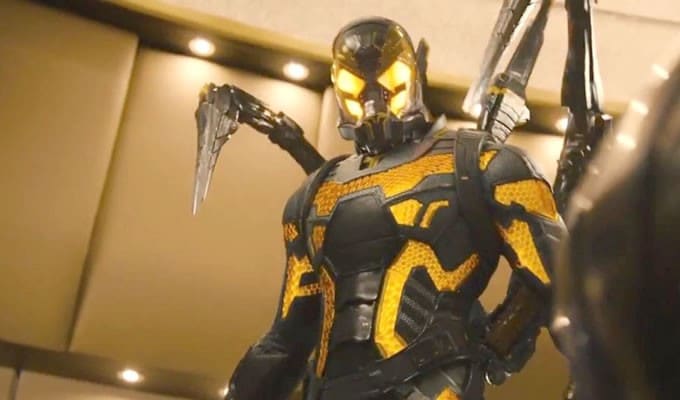
Marvel Studios
It’s no secret that Marvel has a villain problem. Marvel heroes are charming and endlessly likable. They’ve got Chris Pratt and Robert Downey, Jr. on their team. In another year they’ll have Benedict Cumberbatch. There’s no beating that. Whereas the baddies are short on staying power and quickly forgotten (can you name every MCU villain from memory? I blanked on Abomination for a minute there). With two exceptions to the rule: Loki and Kingpin. Maybe Thanos, if he finally sits up from that floating space chair.
With Ant-Man, it’s time to throw another villain on the also-ran pile. Sorry Yellowjacket, but just about every other character in Ant-Man has you thoroughly outclassed. Already you’re starting to blur with with Malekith and Whiplash in my hazy memories of Marvel flicks past.
So yes. Villain problem. And I feel like most people, when they discuss Marvel’s big bad Achilles’ heel, tend to focus on some far-off magic fix. Something creative, like focusing on multiple-movie villains or killing off more hero characters to up the stakes. Like if Marvel Studios just sent out a company-wide memo- hey guys, all villains now do this cool new thing – they’d be pumping out Loki-quality evil every year.
Hell, I even thought of one myself. Ever notice how Marvel heroes stick pretty strictly to their original comic book origins? Marvel’s not nearly so stringent with its villains- they’re typically a pastiche of several characters (Whiplash = Whiplash + Crimson Dynamo), or drastically reworked (the Mandarin, Yellowjacket, Alexander Pierce, Ultron, etc). Who knows? Maybe that’s the golden ticket.
Probably not, though. Because after seeing Ant-Man, the solution to Marvel’s villain problem is screamingly obvious and it’s not something that can be solved with a gimmick or an instant fix. Marvel just need to (gasp) write a decent villain. Put actual effort into the character the way they clearly did making Scott Lang so dashingly likable. Because Yellowjacket gets so little attention in Ant-Man that his motivations/general story arc are riddled with crater-sized plot holes. Like the following:
(Oh, and be advised: these plot holes get a bit spoilery).

Marvel Studios
1. Early on, Hank Pym explains that shrinking can cause a kind of brain damage, and that the Ant-Man helmet is specially insulated to protect the wearer. And because Cross was shrinking without that safeguard, it rattled his brain. But this plot point adds nothing to the film because Cross liquifies an underling for a minor slight in the first act, before any kind of exposure. It’s not like he gets a noticeably crazier from there.
Also, he doesn’t actually shrink until the final fight scene. I mean, maybe he does beforehand. But we don’t see it in the film. And none of the heroes do. I assumed the end battle was his first shrink, which is why it’s so confusing when Hope yells something like Darren, stop! Your shrink-tech has made you insane! How many shrinks does it take before you go looney?
2. Again, we only ever see Cross suit up in the final fight. And when he does, boom- he’s every bit the expert micro-fighter that Scott is. How did Cross get those Yellowjacket skills? Because it’s established that Scott is in above-average shape (the prison fight, the sick ninja flip when breaking into Hank’s place, the abs) and even he needed a major training montage just to jump through a keyhole. And unless I’m getting the timing wrong, Cross mastered his shrink-tech after Scott had already started training. No explanation there.
3. Cross’s climactic I knew your plan all along, YOU FOOLS! stump speech. How did he know every facet of Hank’s plan? I can understand figuring out Scott’s involvement. Probably. I’ll float Ant-Man some credit and assume a man miraculously disappearing from an ant-filled jail cell would have at least made the local news and be relatively common knowledge. Otherwise, I’m at a loss for how Cross knew all that. Unless he really was shrinking throughout the movie and spying on everyone, which would explain his insanity from prolonged shrink-tech exposure. If he actually went insane. Which, seemingly, he didn’t. Alright, I give up.
This isn’t meant to be a knock against Corey Stoll. Stoll’s the man. And House of Cards is proof enough that he’s mastered that delicate balance of lashing out like an awful jerk while hiding something broken and sympathetic inside. Imagine Peter Russo, stewed in booze and lumbering towards Scott’s family in the Yellowjacket suit. That has so much more to offer than a run-of-the-mill megalomaniac’s power trip. Also, he’d be slurring his words and tripping over himself during the final fight. I actually really want to see this, the more I think about it.
The problem with Yellowjacket isn’t Yellowjacket – it’s that all of Marvel’s attention is on the hero, and the villain gets little attention and is usually badly underwritten. One line towards the end – “do I look like a monster?” 00 that Stoll nails with a really wonderful, thoughtful delivery. And a pretty sweet costume. That’s it.
From Marvel’s perspective, it makes sense- at least from a business standpoint. Scott Lang is a long-term investment that’ll drive multiple films, and Darren Cross is not (all Marvel heroes are, really, I’d wager good money that Iron Man’s involvement in Captain America: Civil War bumps up the box office take quite a bit). But the bad guy’s just as important as the good guy – always has been, always will be. Just think of a Marvel movie like a salted caramel. You need somebody salty (and quality salty, like a gourmet Hawaiian black lava sea salt) to make the sweet seem that much sweeter.
